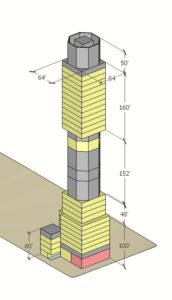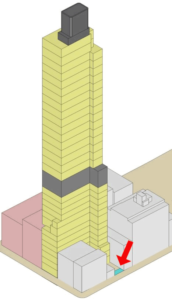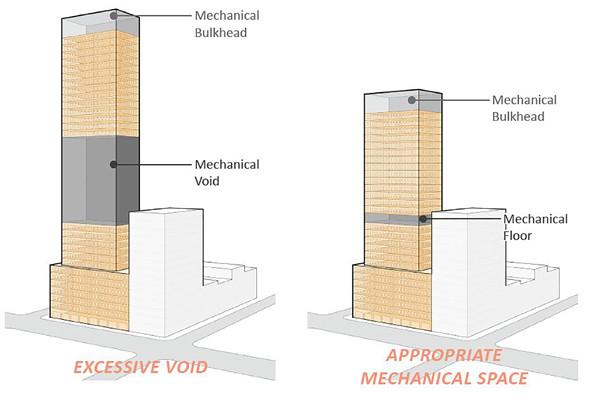The Breakdown: Mechanical Voids Zoning Text Amendment Summary and Impact
On Wednesday, May 29th, the New York City Council voted to amend the Zoning Resolution to cap exempt mechanical void space within new buildings in residential neighborhoods. This text amendment went into effect this week. This ruling is a small but powerful step towards closing commonly-abused “loopholes” and restoring predictability to new construction. So what does this mean?
This zoning text amendment DOES:
-
Codify a height threshold on “free” mechanical void space:
Currently, the allowable zoning floor area of a building does not include spaces used to house necessary mechanical equipment – such as electrical chases, pipe shafts, centralized HVAC systems– that are crucial for buildings to function. Essentially, developers have abused this giveaway to include excessive “free” floor area that far exceeds what is reasonably required to provide necessary mechanical services to a building. Now the exempt spaces will be limited to 25’, or about twice the height that will reasonably accommodate residential mechanical equipment, spaced out at least 75’ from one another. Though the 25’ threshold is generous, it is far more reasonable than the empty spaces exceeding 100’ within new buildings that do nothing to provide community benefits, affordable housing, or an adequate number of units to address the city’s rapidly increasing population.
-
Begin to address the concerns of neighbors, advocates, and elected officials for a zoning text amendment:
The initial Department of City Planning study that led to the agency’s recommendation for a zoning text amendment was a direct response to the advocacy of FRIENDS of the Upper East Side, local elected officials, and advocacy and neighborhood groups. Aiding this campaign was the indispensable urban planner George Janes, whose technical analysis of the zoning tactics leading to unreasonably tall towers in residential neighborhoods informed both the identification of the problem and the discussion of potential solutions.Council Member Ben Kallos and Manhattan Borough President Gale Brewer have been particularly strong allies in this campaign, providing leadership and support from the beginning. In fact, the first public commitment on this issue came at an Upper East Side Town Hall sponsored by Council Member Kallos. FRIENDS’ Executive Director Rachel Levy’s question to Mayor Bill de Blasio about excessive mechanical voids elicited a pledge from DCP Chair Marisa Lago to analyze mechanical voids and deliver a solution.Land use processes are invariably enriched through public influence, and elected officials and advocates showed up in droves to offer public testimony in response to the DCP proposal released in January 2019. While testimony reflected that a comprehensive solution will require further study and more expansive reform, the City has shown its willingness to foster spirited public engagement in the pursuit of addressing legitimate concerns raised by groups like FRIENDS.
This zoning text amendment DOES NOT:
-
Abolish large voids:
Void spaces larger than 25’ in height may still be included in a building’s design for engineering or aesthetic purposes, but voids larger than 25’ will count toward the site’s floor area ratio dictated under the constraints of existing zoning. While the inclusion of empty spaces will be permissible, voids will be more difficult to exploit simply as a height-boosting tactic now that the portions beyond 25’ will be counted toward a building’s maximum size. Note that nothing in the new zoning text requires “mechanical” spaces to serve legitimate mechanical uses. In fact, the DCP study on the excessive voids concluded that the average mechanical floors for all towers in the initial study area of high-density residential districts in Manhattan were 12’ tall. The 25’ threshold codified in the new text already provides more than double the space necessary for average building mechanicals, and itself is a kind of giveaway.
-
Hinder in-progress or approved projects:
Though the closure of the mechanical void loophole will restore some degree of predictability in future structures, it will not retroactively address completed, in- progress, vested, or approved developments that have profited from this tactic.
-
Fully “void the voids”:
It is important to note that this zoning text amendment will only cover enclosed mechanical voids in buildings within Manhattan’s highest density residential districts (R9 and R10 and equivalent). While a powerful step, the scope of this legislation is quite narrow and focuses only on certain voids in certain districts. It will also not comprehensively address such other loopholes as the lack of a codified minimum lot size that prevents developments from evading zoning requirements, or using mechanical voids in commercial districts. However, it is an important first step and “foot in the door,” so to speak, toward the implementation of future measures to ensure predictable growth and protecting the livability of our city.
So What Comes Next?

Geographic scope of residential tower mechanical voids text amendment. Image Credit: New York City Council Land Use Division.
The Department of City Planning has acknowledged that further loopholes need to be addressed by the agency. DCP has committed to completing follow-up zoning studies during Summer 2019 to further expand the geographic scope of the enclosed-voids study into such commercial districts as Lower Manhattan, Midtown, Long Island City, and Downtown Brooklyn. Also this summer, the Department will release results of a study related to the establishment of a minimum lot size for non-residential zoning lots and the impact of tiny, unusual zoning lots. The un-buildable lots issue first came up at 180 East 88th Street, raised by FRIENDS together with Carnegie Hill Neighbors and Council Member Kallos. Advocates and zoning experts believe that a minimum zoning lot size should be mandated in order to limit the manipulation of zoning lot boundaries and mergers simply to skirt existing zoning regulations.
 Massing diagram of 249 East 62nd Street. The grey areas indicate a mix of enclosed and un-enclosed “mechanical” void space. Credit: George M. Janes and Associates
|
 Massing diagram of 180 East 88th Street. The blue square shows the un-buildable lot. Credit: George M. Janes and Associates |
In addition, in Summer 2020 DCP will release its analysis of unenclosed mechanical voids in residential buildings, such as the 150 foot open-air void at 249 East 62nd Street. These unenclosed spaces are NOT covered by this newly-approved mechanical void action. It is not difficult to see how this leaves a gaping hole in the new zoning as developers will likely turn to unenclosed voids to artificially boost upper floors.
These ongoing commitments are a positive sign of DCP’s intention to study other loopholes commonly used in the illegal height-boosting gambits of contemporary buildings. FRIENDS hopes that these studies will yield future zoning text amendments that will be open to debate and commentary in the public arena. We strongly intend to continue working closely with our elected officials to push DCP and the City for more comprehensive and impactful solutions to these issues. We firmly believe that spirited public discourse, though often complicated and rarely expedient, does nothing but enrich the legislative process.
Read More:
- Mechanical void loophole closed by City Council vote,” by Caroline Spivak, Curbed New York, May 13, 2019.
- “City Council passes crackdown on mechanical voids,” by Will Bredderman, Crain’s New York Business, May 29, 2019.
- “City Council’s crackdown on mechanical voids is just the start,” by Georgia Kromrei, The Real Deal, May 30, 2019.
- “No a-voiding this loophole: How to stop unexpected towers,” by Rachel Levy, Crain’s New York Business, April 8, 2019.

Mechanical Voids Zoning Text Amendment Summary and Impact
This program was supported, in part, by public funds from the New York City Department of Cultural Affairs and New York City Department of Youth & Community Development in partnership with the City Council.

